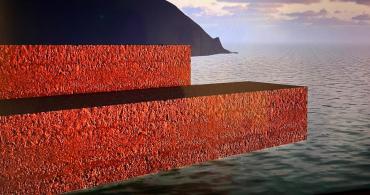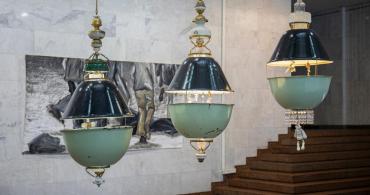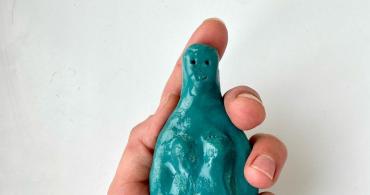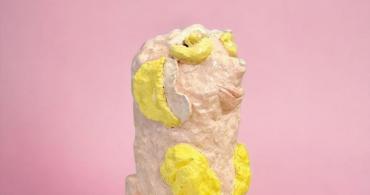Alevtina Kakhidze “is an artist, as well as a gardener,” as she describes herself. Born in Zhdanivka, Donetsk region, she has been living in Muzychi, Kyiv region, for a long time. In her performances and sketches Alevtyna creates narrative stories, where she tackles political issues through a personal perspective. I met Alevtyna for the first time on Maidan during the Revolution of Dignity when we were launching the Postcards from Maidan project. At the time, Alevtyna was drawing postcards that were distributed among the protesters, offering them, for instance, to write a letter home with news from Maidan. At the same time, Romanian artist Dan Perjovschi made a series of drawings reflecting on the Maidan events in Kyiv, as well as the Russian occupation of Crimea. Perjovschi’s concise and eloquent works became an inspiration for many, including Kakhidze. However, as soon as Russia’s full-scale war against Ukraine began, Perjovschi’s (and other European figures) statements lacked clarity in understanding the invasion: instead of calling on Russia to stop its aggression, Perjovschi resorted to the “Putin’s war” cliché, which absolves of responsibility the Russian society, still calling itself “democratic.” We spoke with Dan about his views on the Russian-Ukrainian war in August in an exclusive interview for ArtsLooker. Our conversation with Alevtyna is a virtual dialogue with Perjovschi and a continuation of the artist’s longstanding practice of employing art to tell about what is happening in Ukraine and what the artist’s own family is going through.
In a recent interview with Dan Perjovschi, we discussed his drawings about Ukraine at documenta 15. You criticized those works and even suggested some edits. What are your thoughts on Perjovschi’s practice today?
For me, he was an artist who drew politics. I followed his work and learned from it. But now, I’m arguing with him more and more, and we’ve come to the point where we’re going to try to collaborate.
“I Draw Many Words. He Draws Only One,” Alevtina Kakhidze on a Productive Dispute With Dan Perjovschi and Exhibitions About the War Abroad
22 december, 2023
Why?
For example, when he proclaims in his drawings that he only wants to help refugees, I don’t understand him. I am Ukrainian, and I understand the nature of our war. I know that the number of refugees will correlate with the duration of the war. It means that we can help them endlessly. It’s like fighting the consequences, not the cause. The refugees exist because the aggressor makes it impossible for people to stay in their homes.
Perjovschi also says in his drawings that this is “Putin’s war.” This cliche often appears in the Western media. What do you think is wrong with it?
It’s not very difficult to understand what’s wrong with it. When we emphasize that this is Putin’s war, we give power, greatness, and weight to a person who also has two legs, two arms, and a head. What is his power over others? Why is this his war? Yes, it may sound nice, and it’s easier to write than “Russian-Ukrainian war.” The latter requires using more words. I draw many words. He draws only one.
“I’m against the war,” “Putin’s war” are too simple words for me. For me, being truly radical in your thinking means to ask: How to prevent the war? How to end it?
For example, when he proclaims in his drawings that he only wants to help refugees, I don’t understand him. I am Ukrainian, and I understand the nature of our war. I know that the number of refugees will correlate with the duration of the war. It means that we can help them endlessly. It’s like fighting the consequences, not the cause. The refugees exist because the aggressor makes it impossible for people to stay in their homes.
Perjovschi also says in his drawings that this is “Putin’s war.” This cliche often appears in the Western media. What do you think is wrong with it?
It’s not very difficult to understand what’s wrong with it. When we emphasize that this is Putin’s war, we give power, greatness, and weight to a person who also has two legs, two arms, and a head. What is his power over others? Why is this his war? Yes, it may sound nice, and it’s easier to write than “Russian-Ukrainian war.” The latter requires using more words. I draw many words. He draws only one.
“I’m against the war,” “Putin’s war” are too simple words for me. For me, being truly radical in your thinking means to ask: How to prevent the war? How to end it?
What have you been doing since February 24? How has your life changed?
I’ve got more work. It seems that everyone who knew me wrote and asked for something, to draw or show something. I traveled a lot and talked about what I knew and felt. For example, I did a performance at Centre Pompidou in Paris, where I answered questions that Ukrainians are often being asked, from various perspectives: as a mediator, a wrestler, a tourist, and a gardener. The answers were different, and the work was called The Method of Constructing Political Truth.
I also spoke online at Pompidou during the siege of the Kyiv region. I remember seeing on the screen a huge hall of people gathered, and at the same time, above my head, I saw the archive of my works. And I thought that anything could happen to it anytime. For example, a shell could hit my home, so I said this to the public. Later, I met visitors of that event who said that this was what impressed them most of all…
I’ve got more work. It seems that everyone who knew me wrote and asked for something, to draw or show something. I traveled a lot and talked about what I knew and felt. For example, I did a performance at Centre Pompidou in Paris, where I answered questions that Ukrainians are often being asked, from various perspectives: as a mediator, a wrestler, a tourist, and a gardener. The answers were different, and the work was called The Method of Constructing Political Truth.
I also spoke online at Pompidou during the siege of the Kyiv region. I remember seeing on the screen a huge hall of people gathered, and at the same time, above my head, I saw the archive of my works. And I thought that anything could happen to it anytime. For example, a shell could hit my home, so I said this to the public. Later, I met visitors of that event who said that this was what impressed them most of all…
Please tell us about your Signs of Peaceful Life exhibition at the Meyer Riegger Gallery in Berlin.
I did this exhibition at the invitation of a commercial gallery. They wanted to integrate me into the Western context this way. I worked with a fantastic team at the gallery and felt a lot of support. There was no pressure on what kind of work to show. I decided to tell about myself and what kind of artist I was before the outbreak of the Russian-Ukrainian war. So I showed my old project about consumerist society: about shop windows and beautiful commodities that I loved very much. As a person from Eastern Europe, I talked about my desire to possess them and my lack of readiness for these fantastic Western goods. And I finished with the story of how those shop windows “got scared” during the Maidan Revolution. Although everyone on the Maidan was incomprehensibly polite. I think that Sanahunt’s windows (a luxury boutique in the center of Kyiv that preemptively covered their windows with wooden panels during the Maidan Revolution in 2014 — ed.) were covered not because of people’s [aggressiveness] but because the physical objects (stones) don’t care what to hit, be it someone’s face or a window. That was the first time I made the work from the frightened shop windows series. This metaphor is always with me now, so I showed it too. I also brought the cobblestones of Maidan, which are very similar to those in Berlin. So that people there could see exactly what we were fighting with on Maidan. This work seems to be wrapped in a piece of time.
I also showed drawings from the court proceedings on the Maidan protests. It was crucial for me to remind Europeans of the price of today’s freedom in Ukraine. Being on Maidan was a huge risk even for me, and some people paid with their lives. I showed this episode, perhaps, because I was tired of hearing about how dangerous it is for Russians to protest. We know what it’s like to get killed in your own country by the security forces! I showed pictures from the Maidan court proceedings that lasted all those eight years. They are about the case of Yanukovych, and the case of the snipers, who will be sentenced for the murder of 48 people by the end of the year (at the time of publication, the court had passed a verdict in the case of the mass killing on Maidan – ed.) And about how many Maidan protesters and police officers were actually killed.
From last year’s work, I showed up to 100 drawings. One of them is dedicated to refugees: Ukrainians stand by a lake with foreigners and look at swans. Everyone is looking at the swans, and Ukrainians are looking into their phones, reading the news.
I did this exhibition at the invitation of a commercial gallery. They wanted to integrate me into the Western context this way. I worked with a fantastic team at the gallery and felt a lot of support. There was no pressure on what kind of work to show. I decided to tell about myself and what kind of artist I was before the outbreak of the Russian-Ukrainian war. So I showed my old project about consumerist society: about shop windows and beautiful commodities that I loved very much. As a person from Eastern Europe, I talked about my desire to possess them and my lack of readiness for these fantastic Western goods. And I finished with the story of how those shop windows “got scared” during the Maidan Revolution. Although everyone on the Maidan was incomprehensibly polite. I think that Sanahunt’s windows (a luxury boutique in the center of Kyiv that preemptively covered their windows with wooden panels during the Maidan Revolution in 2014 — ed.) were covered not because of people’s [aggressiveness] but because the physical objects (stones) don’t care what to hit, be it someone’s face or a window. That was the first time I made the work from the frightened shop windows series. This metaphor is always with me now, so I showed it too. I also brought the cobblestones of Maidan, which are very similar to those in Berlin. So that people there could see exactly what we were fighting with on Maidan. This work seems to be wrapped in a piece of time.
I also showed drawings from the court proceedings on the Maidan protests. It was crucial for me to remind Europeans of the price of today’s freedom in Ukraine. Being on Maidan was a huge risk even for me, and some people paid with their lives. I showed this episode, perhaps, because I was tired of hearing about how dangerous it is for Russians to protest. We know what it’s like to get killed in your own country by the security forces! I showed pictures from the Maidan court proceedings that lasted all those eight years. They are about the case of Yanukovych, and the case of the snipers, who will be sentenced for the murder of 48 people by the end of the year (at the time of publication, the court had passed a verdict in the case of the mass killing on Maidan – ed.) And about how many Maidan protesters and police officers were actually killed.
From last year’s work, I showed up to 100 drawings. One of them is dedicated to refugees: Ukrainians stand by a lake with foreigners and look at swans. Everyone is looking at the swans, and Ukrainians are looking into their phones, reading the news.
How did the public respond to the exhibition?
One day I walked into the hall and saw two girls looking at it. They were carefully watching a video of a performance in Perm (The Most Commercial Project performance as part of the Якщо/Если/If exhibition at the PERMM Museum of Contemporary Art – ed.). It was in 2010. Somehow I immediately realized that those girls were Russian. They were talking to each other, then looking at the works from the Maidan. When I approached them to discuss the drawings, I suggested we speak English. And then I realized that they were afraid of me.
You also participated in Manifesta 10, which took place in St. Petersburg. What are your thoughts on working with Russians? Even if they are “good.”
In March 2014, I didn’t understand what Russia was. I received a call from Kasper Könning, the curator of Manifesta 10, while I was looking at Lenin Square in Donetsk, which was full of Russian flags. I went there with a desire to talk about our politics. I succeeded, my work on Manifesta was not censored, but now it’s clear that in the Russian context, any statement was useless. After 2014, I had several other projects in Russia. Emotionally, this resulted in disgust with Russians — all of them. The trust has been lost, and there is no reason to rebuild it. In St. Petersburg, I was taken to the police station because of my project with teenagers called Cartography of Dreams. And a Moscow cameraman who filmed me at the 6th Moscow Biennale, later sent me a private message with a video of my native city of Zhdanivka, occupied at that time, with the caption, “Everything is calm in Zhdanivka.” My mother lived there then, which was the source of enormous anxiety for me until her last days. It was this experience that would become decisive in my relationship with Russia and Russians, although there were many other signs that revealed the imperialism and hostility of the Russians in the Manifesta 10 team, like the “mistranslation” of my bio in the catalog where they called me: “ethnically and culturally Russian.”
One day I walked into the hall and saw two girls looking at it. They were carefully watching a video of a performance in Perm (The Most Commercial Project performance as part of the Якщо/Если/If exhibition at the PERMM Museum of Contemporary Art – ed.). It was in 2010. Somehow I immediately realized that those girls were Russian. They were talking to each other, then looking at the works from the Maidan. When I approached them to discuss the drawings, I suggested we speak English. And then I realized that they were afraid of me.
You also participated in Manifesta 10, which took place in St. Petersburg. What are your thoughts on working with Russians? Even if they are “good.”
In March 2014, I didn’t understand what Russia was. I received a call from Kasper Könning, the curator of Manifesta 10, while I was looking at Lenin Square in Donetsk, which was full of Russian flags. I went there with a desire to talk about our politics. I succeeded, my work on Manifesta was not censored, but now it’s clear that in the Russian context, any statement was useless. After 2014, I had several other projects in Russia. Emotionally, this resulted in disgust with Russians — all of them. The trust has been lost, and there is no reason to rebuild it. In St. Petersburg, I was taken to the police station because of my project with teenagers called Cartography of Dreams. And a Moscow cameraman who filmed me at the 6th Moscow Biennale, later sent me a private message with a video of my native city of Zhdanivka, occupied at that time, with the caption, “Everything is calm in Zhdanivka.” My mother lived there then, which was the source of enormous anxiety for me until her last days. It was this experience that would become decisive in my relationship with Russia and Russians, although there were many other signs that revealed the imperialism and hostility of the Russians in the Manifesta 10 team, like the “mistranslation” of my bio in the catalog where they called me: “ethnically and culturally Russian.”
How do you envision the presentation of your work on international platforms today? What is the most important thing for you to convey to the public?
I recently taught at a French school and realized that those 40 students were the most important audience. Nothing gave me more confidence than sharing the experience of the last ten years in Ukraine and seeing that they found Ukrainian wartime art very relevant.
I recently taught at a French school and realized that those 40 students were the most important audience. Nothing gave me more confidence than sharing the experience of the last ten years in Ukraine and seeing that they found Ukrainian wartime art very relevant.
To read more articles about contemporary art please support Artslooker on Patreon
Share:











